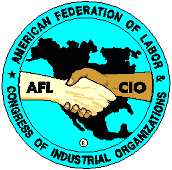Opening
Remarks
American Labor's
Second Century
Toward a Federation
of Labor
Federation of
Organized Trades & Labor Unions
A Testing Period
and Growth
Women in the Unions
Wartime Gains
and Post-War Challenges
From Murdered
Miners to Shiny Dimes
Depression, War and
A Labor Schism Healed
The AFL-CIO Years
On the Farm:
Workers Seek Equality
HOME
E-MAIL
|
|
TOWARD
A FEDERATION OF LABOR
The roots of our country's trade
unions extend deep into the early history of America. Several of the
Pilgrims arriving at Plymouth Rock in 1620 were working craftsmen.
Captain John Smith, who led the ill-fated settlement in 1607 on
Virginia's James River, pleaded with his sponsors in London to send him
more craftsmen and working people.
Primitive unions, or guilds, of carpenters and cordwainers, cabinet
makers and cobblers made their appearance, often temporary, in various
cities along the Atlantic seaboard of colonial America. Workers
played a significant role in the struggle for independence; carpenters
disguised as Mohawk Indians were the "host" group at the
Boston Tea Party in 1773. The Continental Congress met in
Carpenters Hall in Philadelphia, and there the Declaration of
Independence was signed in 1776. In "pursuit of
happiness" through shorter hours and higher pay, printers were the
first to go on strike, in New York in 1794; cabinet makers struck in
1796; carpenters in Philadelphia in 1797; cordwainers in 1799. In the
early years of the 19th century, recorded efforts by unions to improve
the workers' conditions, through either negotiation or strike action,
became more frequent.
By the 1820s, various unions involved in the effort to reduce the
working day from 12 to 10 hours began to show interest in the idea of
federation-of joining together in pursuit of common objectives for
working people.
Puny as these first efforts to organize may have been, they reflected
the need of working people for economic and legal protection from
exploiting employers. The invention of the steam engine and the
growing use of water power to operate machinery were developing a trend
toward a factory system not much different from that in England which
produced misery and slums for decades. Starting in the 1830s and
accelerating rapidly during the Civil War, the factory system accounted
for an ever-growing share of American production. It also produced great
wealth for a few, grinding poverty for
many.
With workers recognizing the power of their employers, the number of
local union organizations increased steadily during the mid-19th
century. In a number of cities, unions in various trades joined
together in city-wide federations. The National Trades' Union, formed in
1834 by workers in five cities, was an early attempt at countrywide
federation-but the financial panic of 1837 put an end to its
efforts. In 1866 several national associations of unions
functioning in one trade-printers, machinists, stone cutters, to name a
few-sent delegates to a Baltimore meeting that brought forth the
National Labor Union. Never very strong, it was a casualty of the
sweeping economic depression of 1873.
Five years later, the Knights of Labor captured the public
imagination. The Knights were an all-embracing organization
committed to a cooperative society. Membership was not limited to wage
earners; it was open to farmers and small business people-everybody,
that is, except lawyers, bankers, stockbrokers, professional gamblers
and anyone involved in the sale of alcoholic beverages. The
Knights achieved a membership of nearly 750,000 during the next few
years, but the skilled and unskilled workers who had joined the Knights
in hope of improvement in their hours and wages found
themselves frustrated by the Knights' vague organizational structure, by
its officers' aversion to strikes against employers and by its leaders'
reliance on
the promise of future social gains instead of the hard day-to-day work
of building and operating a union organization. So the stage was
set for the creation of a down-to-earth, practical labor federation
which could combine long range objectives of a better society with the
practical activity of day-to-day union functions.
Back to
Top
[Home]
[373
Officers] [Upcoming
Events] [Links
to Other Unions]
[Local
373 E-mail] [Webmaster
E-mail] [373
Members E-mail Directory]
[Ironworkers'
Prayer] [History
of American Labor]
[Sign
Guestbook] [View
Guestbook] |

